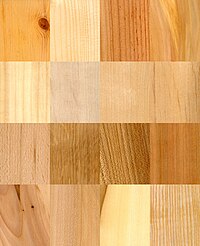
Photo from wikipedia
Abstract Earlywood (EW) and latewood (LW) have different hygromechanical behaviors, if subjected to relative humidity (RH) variations. To understand this effect better, the adsorption mechanisms of EW and LW of… Click to show full abstract
Abstract Earlywood (EW) and latewood (LW) have different hygromechanical behaviors, if subjected to relative humidity (RH) variations. To understand this effect better, the adsorption mechanisms of EW and LW of Douglas fir were studied by 2D 1H NMR relaxometry under conditions of equilibrium moisture content (EMC) at 20°C. Two bound water components were detected with relaxation times T1 and T2 indicating that they are located in distinct environments but these are similar in EW and LW. Sorption isotherms were calculated and analyzed based on the sorption model of Dent. A difference of sorption energy between the two water components is in agreement with their mobility difference observed on T1−T2 correlation spectra. Moreover, for the two bound water components, EW and LW exhibit different sorption isotherms at high RH. This may be attributed to a difference of adsorption capacity. Based on the macrofibril models provided by the literature, the following hypothesis is proposed: bound water components are located in lamellar and lenticular areas, both leading to possible deformations.
Journal Title: Holzforschung
Year Published: 2017
Link to full text (if available)
Share on Social Media: Sign Up to like & get
recommendations!